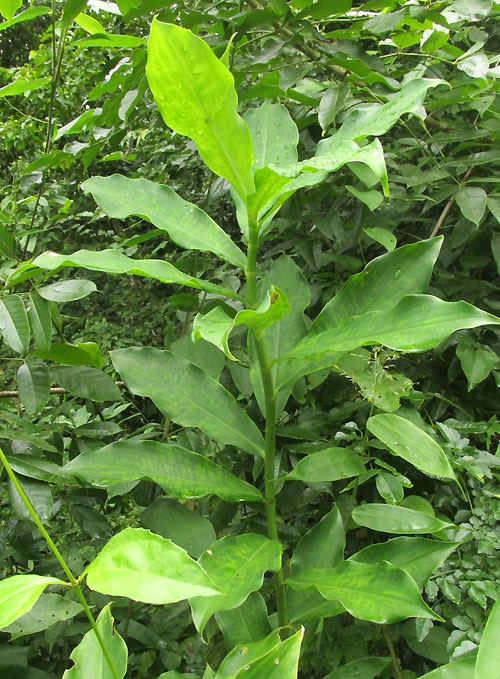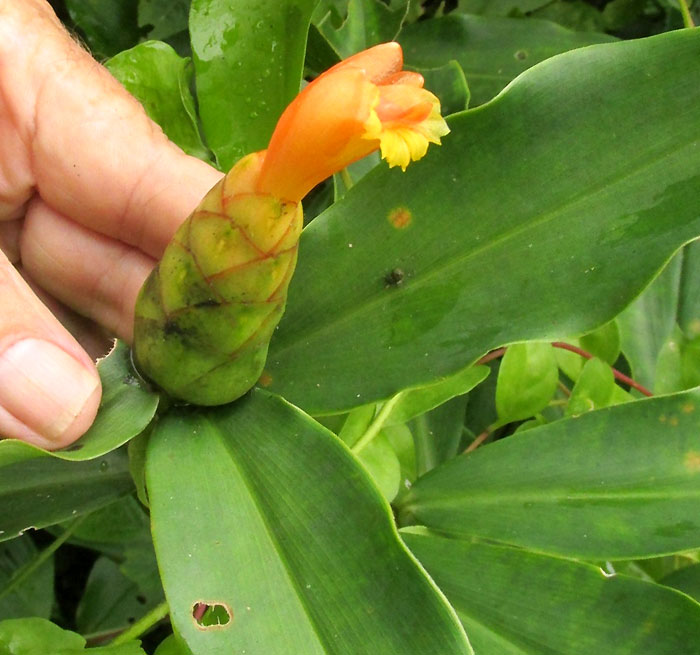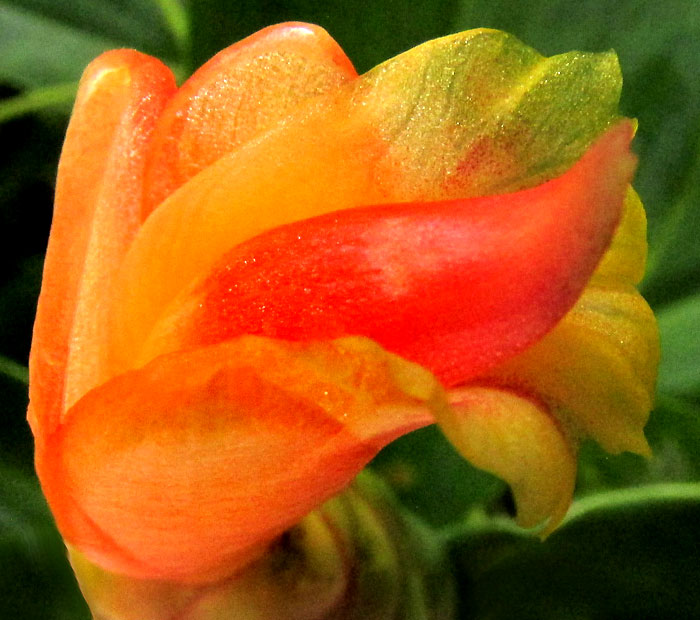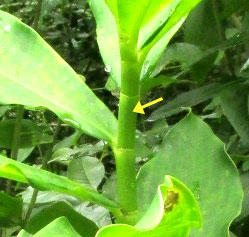Excerpts from Jim Conrad's
Naturalist Newsletter
entry from field notes dated October 7, 2022, taken about 3kms north of Gómez Farías, on the lower eastern slope of the Eastern Sierra Madres, El Cielo Biosphere Reserve, southern Tamaulipas state, MÉXICO; elevation about 300m (1000 ft), ± LAT. 23.04°N, LONG. -99.15°W
SPIRAL GINGER

Among bushes and weeds beside the narrow, much eroded gravel road descending from Gómez Farías into Cañón el Azteca, Aztec Canyon, about 3 kms north of town, the above two-meter-tall plant (7ft) caught my eye with its fair-sized, tongue-shaped leaves spirally arranged on an erect, unbranching, thick, herbaceous stem. The leaves' veins paralleled one another as in grass blades, so here was a monocot, unlike the dicot net-veined, broad-leafed bushes and weeds around it. Nearby, another similar, shorter plant bore a flowering head atop its stem:

Above, a yellowish flower emerges from behind a scale-like bract, in a cone-like, spike-type inflorescence covered with numerous overlapping bracts. As the flowering head matures, one or two flowers will emerge from each bract. Some sources describe individual flowers as lasting just one day. Blossoms display bilateral symmetry, with one side being a mirror image of the other.

Up close, most of us may be confused by not recognizing the usual flower features of calyx, corolla, stamens, pistil, etc. Amazingly, in the above picture the large, reddish, teardrop-shaped item is the flower's single stamen. Anatomists refer to it as a "petaloid" stamen -- petal-like -- in which the pollen-producing anther and female parts lie hidden inside the reddish "petaloid structure" wrapping around them. When hummingbirds pollinate the flowers, they insert their beaks into the petaloid structure. In the picture, the reddish stamen is cradled in an expansive, scoop-shaped, mostly yellow, shallowly lobed lip, or labellum. The lip emerges from among three reddish-yellow corolla lobes rounded at their tips.
We've encountered plants somewhat similar to this. For example, there's the Red Ginger, Alpinia purpurata, and the even more similar Crepe Ginger, Costus speciosus. Both of these "gingers" are much planted in tropical gardens, but they're not "real gingers," in the sense that a pungent spice can't be derived from their rhizomes, and they're not the much-cultivated ginger-root plant Zingiber officinale. So, what is this roadside plant?
Each of the above linked-to "gingers" belongs to a different plant family. Red Gingers belong to the Ginger Family, the Zingiberaceae, while Crepe Ginger is a member of the Spiral Ginger Family, the Costaceae. These two families are very closely related -- earlier the species were lumped in a single family -- and are presumed to have arisen from the same common ancestor; They're "sister taxa." At first glance, the non-flowering plant at the top of this page could well have been a member of the Ginger Family. However, here's what's said about the Spiral Ginger Family at the Missouri Botanical Garden's authoritative Embryopsida Page:
Costaceae can easily be recognised even vegetatively: they have ligulate leaves with a closed sheath that are arranged in a single spiral up the stem.

In the image at the right you can see that this plant's leaves spiral up the stem, and the yellow arrow points to a leaf sheath surrounding the stem below the point of attachment of a leaf blade, and that sheath is "closed" -- no slit cutting down the side opposite the point of attachment of the blade on the opposite side of the stem. Therefore, our plant belongs to the Spiral Ginger Family, the Costaceae. Another helpful field mark is that spiral gingers contain no aromatic oils, which look-alike members of the Ginger Family do.
The Spiral Ginger Family is a small one, currently considered to embrace worldwide only about 143 tropical species in seven genera, with the family's center of diversity being in the Americas. In Mexico only one genus of the family is represented, the family's most species-rich one, the genus Costus. All Costus species may be referred to as spiral gingers.
No general treatment of Mexican spiral gingers is available. The best analysis may be the 1994 study of the family appearing in the Flora de Veracruz. There four Costas species are documented for Veracruz state, which is the state immediately south of us. On the Internet, our plant matches pictures of only one of the four Veracruz species, and that species is the only species I can find documented for Tamaulipas state. It's COSTUS SCABER.
At first I hesitated to accept that identification because nearly all pictures of Costus scaber show the species' cone-like flowering head as bright red, while ours is greenish yellow. Maybe our head is very young or, maybe, since we're at the northern extreme of the species' distribution in Mexico, plants here just are a little different from most of the species. Individuals at the edges of a species' main population often diverge a little from "average" features, just as most Inuit look a little different from humans adapted to live farther south. Whatever the case, despite the greenish-yellow flowering head, the process of elimination confirms that our plant could hardly be anything other than Costus scaber.
Costus scaber is distributed from here in northeastern Mexico south through Central America to Brazil and Perú in South America. It's described as inhabiting tropical evergreen and semi-evergreen forests, mountain forests, and disturbed areas in those forests, from sea level to 1000m (3300 ft).
Over the species' large distribution area, various traditional medicinal uses have been documented for the plant. Uses range from bringing down the fever to dealing with kidney ailments, snakebites, thirst and the effects of having endured too much sunlight. The 2008 publication by Peter Taylor and others entitled Evaluation of Venezuelan Medicinal Plant Extracts for Antitumor and Antiprotease Activities reports that extracts of Costus scaber are "potent and selectively inhibitory for one or two {human tumor} cell lines."
In warmer regions several spiral ginger species are cultivated as ornamentals, including our Costus scaber, though that species isn't as gaudy and popular as some others.